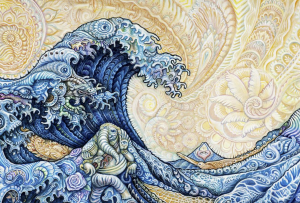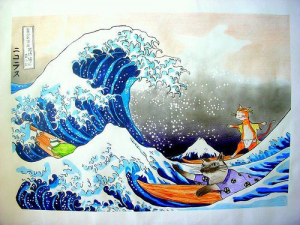 This month our Moving into Meditation class continues study of the Yoga Ethic of Santosha. Santosha inspires us to cultivate contentment.
This month our Moving into Meditation class continues study of the Yoga Ethic of Santosha. Santosha inspires us to cultivate contentment.
“When at peace and content with oneself and others (Santosha), supreme joy is celebrated.” Yoga Sutra 2.42 translation by Nischala Joy Devi, The Secret Power of Yoga
Today we drew our inspiration from Roger Keyes beautiful poem, Hokusai Says (link to Roger’s reading of the poem). The poet Roger Keyes is an American professor of East Asian studies. This poem is apparently his cross-media translation of the art of Katsushika Hokusai (1760-1849) into poetry. The poem says: “. . . Contentment is life living through you. Joy is life living through you. Satisfaction and strength is life living through you . . . “ Our guided relaxation incorporated lines of this extraordinary poem of mindfulness.
Hokusai says look carefully.
He says pay attention, notice.
He says keep looking, stay curious.
He says there is no end to seeing.
He says look forward to getting old.
He says keep changing,
you just get more who you really are.
He says get stuck, accept it, repeat
yourself as long as it is interesting.
He says keep doing what you love.
He says keep praying.
He says everyone of us is a child,
everyone of us is ancient,
everyone of us has a body.
He says everyone of us is frightened.
He says everyone of us has to find
a way to live with fear.
He says everything is alive–
shells, buildings, people, fish,
mountains, trees, wood is alive.
 Water is alive.
Water is alive.
Everything has its own life.
Everything lives inside us.
He says live with the world inside you.
He says it doesn’t matter if you draw,
or write books. It doesn’t matter
if you saw wood, or catch fish.
It doesn’t matter if you sit at home
and stare at the ants on your veranda
or the shadows of the trees
and grasses in your garden.
It matters that you care.
It matters that you feel.
It matters that you notice.
It matters that life lives through you.
 Contentment is life living through you.
Contentment is life living through you.
Joy is life living through you.
Satisfaction and strength
is life living through you.
He says don’t be afraid.
Don’t be afraid.
Love, feel, let life take you by the hand.
Let life live through you.
In her article, Santosha: Practicing the Art of Contentment, yoga instructor, Emily Hightower, writes:
“When we let go of the urge to constantly fix and fill . . . when we’re present with whatever is coming up in the moment, the moment presents perfectly all that is.
We can face it; we are part of it. Here we enter a space that contains an energy of peace, presence, and potential. When we access it, we are content.”
Present awareness invites us on a “quest to align ourselves with choices that create personal and cultural healing. It implies that once awake to a problem, contentment rises up when we know we are acting on it. . . .” It matters that we care. It matters that we feel. It matters that we notice. It matters that life lives through us.
“. . . Santosha is our calling to act . . . towards harmony by expanding fulfillment rather than lack or guilt. The more we practice contentment, the more we have access to it. . . . ”
We can answer the call . . . to be engaged . . . generous . . . kind . . .
‘We should be careful
Of each other, we should be kind
While there is still time.’
The Mower, Philip Larkin
Mantra & Pranayama Practice
We initiated our movement practice with mantra and pranayama using the So Hum mantra. So Hum is a reflection of the sound of the breath . . . it affirms life living through you. . . meaning: “I am that” so = “I am” and hum = “that”. “That” refers to all of creation, the one breathing us all. It’s a simple practice you can easily incorporate into your day:
Find a comfortable posture for meditation (seated on a cushion or blanket, in a chair or against a wall). Place your palms facing up in jnana mudra (forefinger and thumb touching) with your palms facing up to open your awareness or facing down to calm the mind.
Bring your attention to the tidal rhythm of your breath, feeling the rise and fall of your inhalation and exhalation. As your focus settles on your breath, beginthe simple mantra “so hum.” As you inhale, silently say “so” to yourself and as you exhale, say “hum.” Once the “so hum” rhythm has been established, begin to contemplate the meaning of “so hum.” As you inhale with the mantra “so,” say to yourself ” I am,” connecting to your essential self. Contemplate the source of your breath: Where is your breath coming from? Sense the billions of human beings and countless creatures on Earth being fed by the same tidal rhythm of the breath.
As you exhale with “hum,” inwardly say “that” or “all that is.” Feel how your exhalation releases you into the expanse around you. Visualize your exhalation leaving your body through your nostrils and then merging back into the atmosphere, back into infinity, back into “all that is.” Stay with this contemplation until you naturally begin to settle into a state of unified consciousness however brief.
Sharing & Resources
In our discussion we touched on the importance of understanding ourselves as complex creatures whose behaviors are driven by our genetic inheritance and conditioning. Together we can encourage each other to incline our minds toward compassion and empathy. Mutual understanding and support can often give us the boost we need to override reactive impulses. At the very least it may help to foster tolerance. For a fascinating exploration of our human nature – what drives us and how we contend with our drives check out The Biology of Good and Evil, a conversation between neuroscientists Dr. Robert Sapolsky and Sam Harris.
Thank you for your caring, feeling and noticing. Gassho and namaste.

